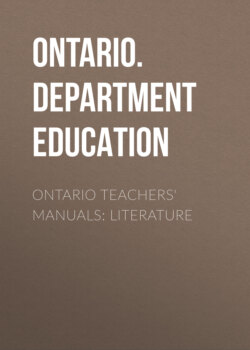Читать книгу Ontario Teachers' Manuals: Literature - Ontario. Department of Education - Страница 19
На сайте Литреса книга снята с продажи.
AIMS IN TEACHING LITERATURE
ОглавлениеTable of Contents
The teacher should always have a clear and definite aim in view in teaching a selection in literature, but different teachers may have different aims in teaching the same selection. There should, of course, always be the general aim to create a taste for good literature by leading the pupils to appreciate the beauty and power of clear and artistic expression of thought and feeling; but this aim must be specific according to the nature of the selection to be taught. Some specific aims may be given as suggestive:
1. To appeal suitably to such instinctive tastes and interests of childhood as are already awake and active; for example, Second Reader, p. 3, My Shadow; p. 185, A Visit from St. Nicholas; p. 125, Little Gustava; p. 215, The Children's Hour.
2. To awaken and develop interests and tastes that are as yet dormant; for example, Second Reader, p. 42, A Song for Little May; p. 88, The Brown Thrush.
3. To develop and direct the imagination; for example, Second Reader, p. 72, The New Moon; p. 117, Little Sorrow; p. 45, The Little Land; p. 172, The Wind.
4. To arouse and quicken the sense of beauty; for example, Second Reader, p. 92, Mother's World; p. 155, Lullaby.
5. To exercise and cultivate the emotions; for example, Second Reader, p. 94, Androclus and the Lion; p. 135, Ulysses; p. 107, A Night with a Wolf.
6. To develop manners and morals through examples of character and conduct in action; for example, Second Reader, p. 114, Joseph II and the Grenadier.
7. To develop appreciation for the well-told story; for example, Second Reader, p. 5, The Pail of Gold; p. 12, How I Turned the Grindstone; p. 56, The Blind Men and the Elephant; p. 211, How the Greeks Took Troy.
8. To develop a true sense of humour; for example, Second Reader, p. 50, Change About.
9. To develop a sense of reverence; for example, Second Reader, p. 203, The Lord is my Shepherd; p. 218, Abide With Me.
